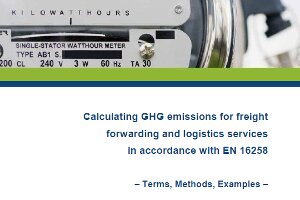 The GIZ Green Logistics project advises Chinese partners such as the Ministry of Transport (MoT) in the field of carbon foot printing in logistics. The project contributes to capacity development of decision makers and the introduction of new concepts and standards. Within this context the DSLV guide was translated into Chinese to outline the European approach to local partners and to provide a resource document.
The GIZ Green Logistics project advises Chinese partners such as the Ministry of Transport (MoT) in the field of carbon foot printing in logistics. The project contributes to capacity development of decision makers and the introduction of new concepts and standards. Within this context the DSLV guide was translated into Chinese to outline the European approach to local partners and to provide a resource document.
Manage carbon emissions from logistics is a complex task and a major challenge for reducing energy consumption of the freight transport industry. The European Committee for Standardization (CEN) approached this problem by introducing the CEN standard EN 16258, “Methodology for Calculation and Declaration of Energy Consumption and GHG Emissions of Transport Services (freight and passengers)” at the beginning of 2013 to quantify the environmental foot print of logistic activities. The standard provides a common methodology for the calculation, declaration and reporting on energy use and GHG emissions of transport services. It specifies guidelines, general principles, definitions, system boundaries, measurement rules, calculation methods, and data sources.
However, the standard remains complex and theoretical. Therefore, the German alliance of forwarder and logistic companies (DSLV) published the implementation guide “Calculating GHG Emissions for Freight Forwarders and Logistics Services” in accordance with EN 16258 in German language. This guide supports logistics providers with further operational details to facilitate the implementation of the CEN standard. The English language edition was published by the European Association for Forwarding, Transport, Logistics and Customs Services (CLECAT) in 2013.
Download the English and Chinese version of the DSLV guide here:
“CLECAT Guide on Calculating GHG Emissions for Freight Forwarding and Logistics Services”
“DSLV Guide on Calculating GHG Emissions Freight Forwarding and Logistics Services_CN”




Comments are closed.